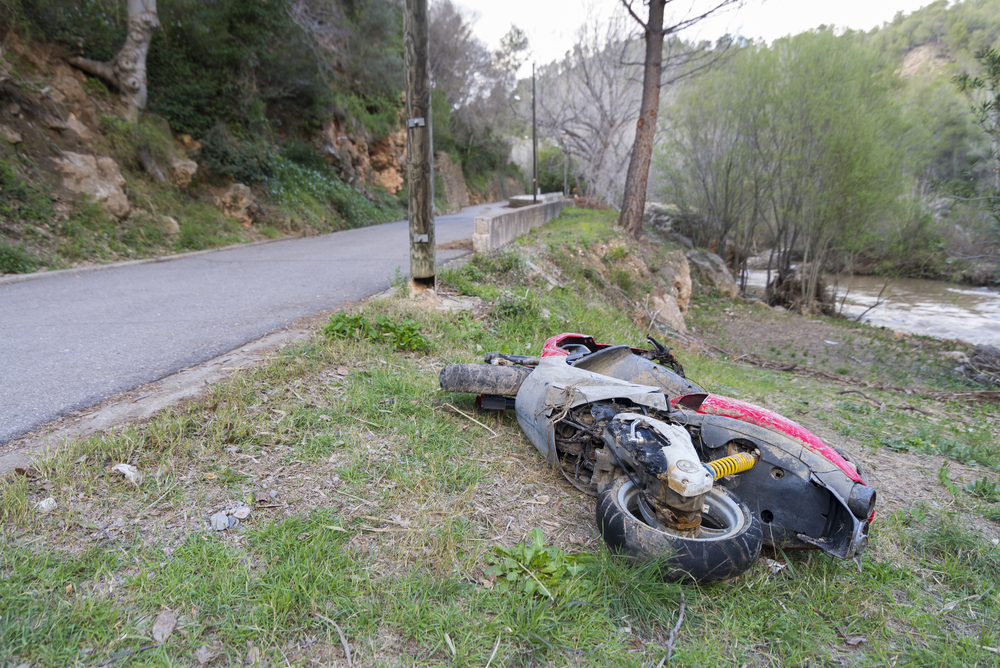
Florida has extensive traffic laws that exist to protect everyone on the road, including motorcyclists. Drivers must follow these laws at all times. If someone violates the law while driving and causes property damage or bodily injury, they can be civilly liable for any resulting harm. A reasonable driver observes traffic laws, as does a motorcyclist.
The difficulty after a motorcycle accident case is proving that the driver violated a traffic law or did something else unreasonable. If you cannot meet your burden of proof, you are not legally entitled to financial compensation. For this reason, you need to hire an experienced motorcycle accident lawyer. Otherwise, you can end up either empty-handed or with far too little compensation to cover your actual injuries.
Drivers Must Follow General Traffic Laws With Regard to a Motorcyclist
 No special laws dictate how a driver must treat a motorcyclist. However, violating standard traffic laws will get a driver a moving violation.
No special laws dictate how a driver must treat a motorcyclist. However, violating standard traffic laws will get a driver a moving violation.
In Florida, a motorcycle is the same as any other vehicle on the road. A motorcyclist has a complete right to their own space in the lane in traffic. According to Florida law:
“Any person operating a motorcycle or moped shall be granted all of the rights and shall be subject to all of the duties applicable to the driver of any other vehicle.”
What this also means is that a motorcyclist is equal to anyone else when it comes to the law. They must follow the same laws (although some special laws apply to motorcycles). Motorcyclists can also break the law when they are doing something like speeding. Nonetheless, who was at fault in a motorcycle accident depends on the facts and evidence.
Drivers Can Violate Laws That Cause Serious Injuries
Some traffic law violations will lead to serious motorcycle accidents. One of the first major laws that protect motorcyclists is the prohibition on using a hands-free device while driving. Texting behind the wheel and other forms of distracted driving create a serious danger for motorcyclists.
Drivers must pay special attention to see bikers because motorcycles are much smaller than other vehicles. If a driver is not paying close attention to the road, they may cut off a motorcyclist, causing them to lose control of their bike. They may run into the back of the motorcycle or cause a sideswipe accident.
Drivers Cannot Make Dangerous or Illegal Turns
Another major law is that drivers must check their blind spot and signal when changing lanes. Drivers often will change lanes without looking or signaling. They do not alert the biker that they are coming into their lane. The lack of a signal can cause an accident while changing lanes. Sideswipe accidents are dangerous for motorcyclists because they will knock the biker to the ground on contact.
At the same time, drivers can only make left-hand turns from the left-hand lane (the same goes for right turns from the right lane). In some cases, drivers may turn from the wrong lane and cut across the lane where the motorcyclist is traveling. This illegal turn has the same effect as an illegal lane change, cutting the biker off in traffic.
Drivers Must Allow for a Safe Following Distance
Another major law that can protect a motorcyclist from an overaggressive driver is the prohibition on tailgating. Often, motorists will get too close to the back of a motorcycle. When the bike has to stop in front of them, the car will crash into the back of the motorcycle.
Rear-end crashes into a motorcycle are a completely different thing than accidents with a car. Rear-end car crashes are serious enough, with the front driver often suffering whiplash. In a rear-end accident with a motorcycle, the passenger car driver will run directly into the back of the motorcyclist. With nothing to protect themselves from direct impact, motorcyclists will often suffer serious physical injuries.
A rear-end crash will often cause a motorcyclist to fly forward off their bike. This regularly results in severe injuries to the motorcyclist’s head, face, hands, and arms.
Drivers Cannot Speed
Finally, drivers must also adhere to the speed limit and travel at a speed that is reasonable for the circumstances. For example, a reasonable speed may be under the speed limit during a rainstorm.
When drivers speed, they often get too close to the motorcycle. The driver also does not have their full reflexes, and they cannot respond to prompts and challenges in their general vicinity. Motorists often cannot stop in time to avoid an accident when driving too fast. They may lose control of their own car, careening into the motorcyclist’s path.
Drivers Have a Legal Obligation to Exercise Due Care
One main rule that applies equally to everyone is that motorists owe the same exact duty of care to bikers as they do to everyone else on the road. The motorist must exercise a reasonable amount of care behind the wheel. If they injure a motorcyclist, they have the same legal obligation to pay financial compensation as they will if they injure another motorist or their passenger.
Reasonable care is the same thing an average driver should do under the circumstances. The average driver follows all the traffic rules and laws described above. Although the law does not expect a driver to be perfect, they also cannot be careless or reckless. If the driver acted unreasonably under the circumstances and they injured the motorcyclist, the driver has a legal obligation to provide financial compensation. Assuming that the driver had insurance, the insurance company should step in and cover the liability to the motorcyclist.
An Ordinary Driver Follows Traffic Laws
Reasonable care refers to what an average and careful driver should do under the circumstances. The average driver follows all traffic laws. They are not superhuman or absolutely perfect, but they must pay attention and use the skill and caution that an ordinary driver should. In other words, the fact that a motorcycle accident happened is not evidence in itself that a driver did something wrong. Instead, you need to compare what this driver actually did to what a reasonable driver should have done.
How to Prove a Driver Violated the Law
To prove your case, you need persuasive evidence regarding the negligence and liability of the driver.
You might rely on:
- Pictures of the accident scene
- Video camera footage or dashcam footage
- The police report
- Citations the police issued to the other driver
- Testimony from an accident reconstruction expert
You do not have to seek out evidence to prove your case. You can focus on your medical treatment and physical healing while your motorcycle accident lawyer gathers evidence of liability for your accident.
You Cannot Use the Police Report in All Circumstances
The police report may contain some of the officer’s preliminary impressions about the accident. It will likely include what they saw when they arrived at the scene and what the witnesses who saw the crash said afterward. However, the police report will usually not reach an outright conclusion about who was to blame. The insurance companies can review the police report and might find it very helpful in their liability determination.
However, if you ultimately file a lawsuit, you cannot introduce a police report as evidence at trial. Without the police officer’s testimony, the court may consider the accident report hearsay, courts generally will not admit.
Your attorney might call the police officer as a witness to authenticate the information in the police report and testify to what they witnessed at the accident scene. Your lawyer can gather their other evidence that can prove the same things that the police officer observed, even if the police report itself cannot be evidence in a court proceeding.
A Traffic Ticket Can Help With Your Motorcycle Accident Case
One thing that can help your insurance claim is when a police officer shows up at the scene and issues a citation to the driver due to probable cause that the driver violated the law. Insurance companies will consider this fact when determining liability for the accident.
If the driver pleads guilty to an offense in traffic or criminal court, it helps a civil lawsuit. In many cases, a conviction is all you need to convince an insurance company of liability.
The Insurance Company May Still Try to Blame the Motorcyclist
The insurance company will look at what you did in the lead-up to the accident and potentially try to use it to disqualify you from receiving financial compensation or to reduce it.
Just like other drivers have to follow laws, you also have an obligation to comply as a biker. For example, the insurance company may try to claim that you were speeding or driving recklessly. Insurance companies like to portray motorcyclists as risky people and stereotype them every step of the way because it saves them money.
One thing that might come into play is Florida’s motorcycle helmet law. In Florida, only motorcyclists under 21 must wear helmets on a bike, as fully insured adult motorcyclists can lawfully opt to forgo a helmet.
Still, the insurance company may try to blame your injury on the fact that you were not wearing a helmet, deliberately overlooking the fact that you may have still suffered an injury anyway, even if you were wearing a helmet. Choosing not to wear a helmet is within your rights under Florida motorcycle laws, so the insurance company should never use this against you.
Your Lawyer May Need to Justify Your Actions
Unfortunately, your lawyer’s job may be every bit as much to defend you as it is to prove that the other driver did something wrong. That is the way that it works in many personal injury claims.
It is even more true in a motorcycle claim when the insurance company has to pay out more money because of the severity of your injuries. The insurance company has even more motivation to come after you personally to save itself money.
The Insurance Company Cannot Get Away with Shading the Facts When You Have a Lawyer
In the end, the facts and the law will speak for themselves, regardless of what the insurance company says in the case. When you are talking to the insurance company, it is legally as if you are dealing with the responsible driver since they are the representative.
In other words, the insurance company does not get to set the rules or have the final say in your case. If the insurance company is trying to create a new reality that lets their driver off the hook for breaking the law, you can and should sue the other driver in court and let the jury decide the matter once and for all.
Your Lawyer Investigates and Gathers the Evidence of What Happened
 What matters the most in your motorcycle accident case is evidence. You must prove that the driver either broke the law or that they did something careless that caused your accident.
What matters the most in your motorcycle accident case is evidence. You must prove that the driver either broke the law or that they did something careless that caused your accident.
If you do not have the necessary proof, you will not recover financial compensation. It is difficult for you to gather your own evidence that can prove liability for your accident, both at the scene of the crash and in the days afterward. Unfortunately, motorcycle accident evidence can disappear quickly if you do not take steps to secure it.
An attorney can immediately get to work to gather the evidence that shows what the driver did, so you can compare it to what a reasonable driver should have done under the circumstances. However, you must call an attorney as soon as possible after the accident. If you wait too long, you may lose the ability to prove your case. One thing that works in your favor is that you do not need to pay an attorney at the time you hire them. You will not even need to pay them at all unless you win your case.



